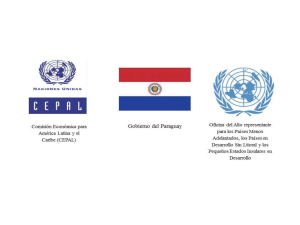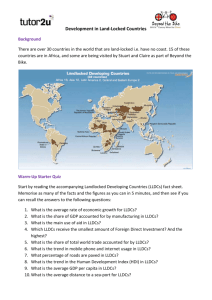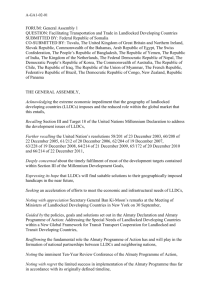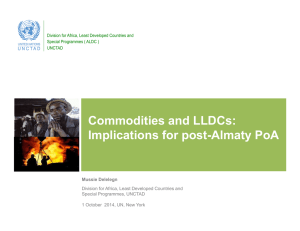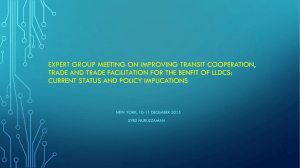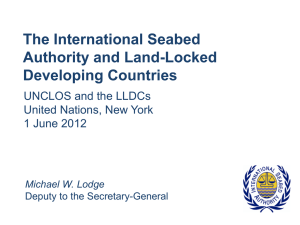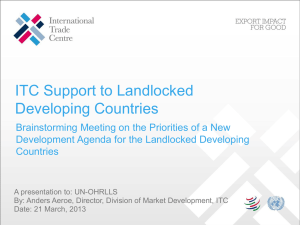Global perspectives - United Nations Economic Commission for Africa
advertisement
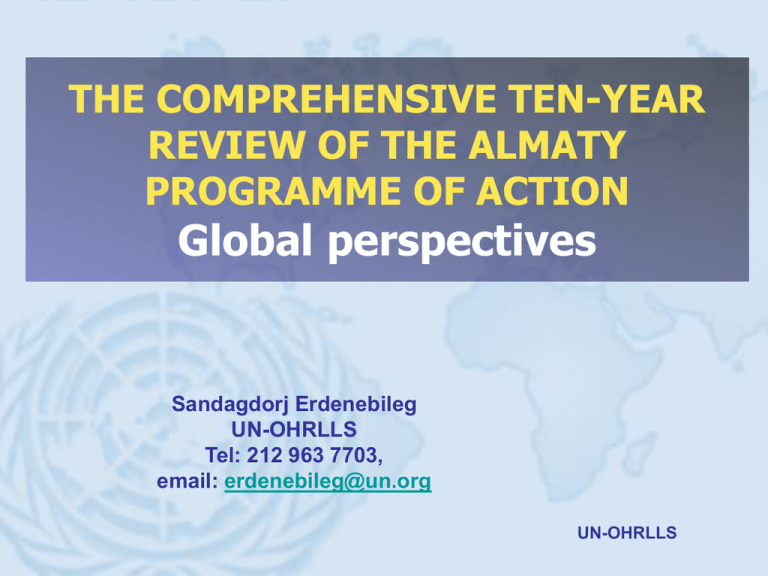
THE COMPREHENSIVE TEN-YEAR REVIEW OF THE ALMATY PROGRAMME OF ACTION Global perspectives Sandagdorj Erdenebileg UN-OHRLLS Tel: 212 963 7703, email: erdenebileg@un.org UN-OHRLLS Almaty Programme of Action - 2003 APoA – comprehensive development agenda focused on transit cooperation. • Key objectives - Increase export competitiveness through reducing trade transaction costs • Develop genuine partnerships at national, bilateral, sub-regional, regional and global levels -between LLDCs and transit countries with their development partners and between the private and public sectors • Priority areas: i) Fundamental transit policy issues ii) Infrastructure development and maintenance iii) International trade and trade facilitation iv) International support measures v) Implementation and review UN-OHRLLS LLDCs continue to face problems Transit and transport related problems: – Inadequate transit infrastructure – Remoteness from major international markets – Inefficient logistics systems – Delays in transit – due to checkpoints/unscheduled roadblocks, cumbersome customs and border crossing procedures and insufficient application of ICT, excessive number of documentation Other challenges: – Heavy reliance on low-value – high-bulk commodities which make them vulnerable to commodity price volatility – Limited productive capacities – High vulnerability to the global financial and economic crisis, food security, climate change and desertification UN-OHRLLS and land degradation Cost of being landlocked: Results of OHRLLS study • Study applied a gravity model to data from 150 including LLDCs and coastal countries over the period 1980-2010. • LLDCs’ trade was just 61% of the trade volume of coastal countries in 2010. In 2004 it was 57%. • Transport costs for LLDCs were 45% higher than the representative coastal economy in 2010 and have increased over time. • Because of landlockedness the level of development in the LLDCs is on average 20% lower than what it would be were the countries non-landlocked. ====== Improved Transport and Trade Facilitation are still key to reducing the costs for LLDCs. UN-OHRLLS Since 2003 LLDCs experienced high economic growth GDP growth (percentage) 10 8 6 4 2 0 2003 2004 2005 2006 2007 2008 2009 2010 2011 -2 World LLDC average -4 UN-OHRLLS LLDC per capita GDP increased – Less than transit countries; 14 African LLDCs below $ 1,000 3000 2500 2000 1500 1000 500 0 2000 2001 2002 2003 2004 2005 2006 2007 2008 2009 2010 2011 LLDC Average African LLDCs Transit Countries Average UN-OHRLLS Declining value addition in manufacture and agriculture LLDCs economies Manufacturing Value Addition (Share of GDP) 20 16 14 12 10 8 6 4 2 LLDC LDCs TRANSIT COUNTRIES 2011 2010 2009 2008 2007 2006 2005 2004 2003 2002 2001 2000 1999 1998 1997 1996 1995 1994 1993 1992 1991 0 1990 Percentage of GDP 18 Human Development Index (HDI) has improved but lower than other groups UN-OHRLLS African LLDCs have lower HDI 0.70 0.60 0.50 2000 0.40 2005 2010 0.30 2012 0.20 0.10 0.00 All LLDC African LLDCs MDGS Advances on some MDG indicators • Net primary school enrolment increased from 64% in 2000 to 83% in 2011 • Share of women in national parliament increased from 7.8% in 2000 to 23.5% in 2013 • HIV prevalence rate decreased from 4% in 2001 to 2.8% in 2011 • Under-5 mortality rate declined from 121.5 per 1,000 live births in 2000 to 80.9 in 2011 However challenges remain • Prevalence of undernourishment in all LLDCs was 22% in 2011 and African LLDCs 31% • In half of the LLDCs the proportion of the population living under $1.25 per person per day is greater than 20% • GDP per capita (constant 2005 $) is below $1,000 in 19 LLDCs, 13 of which in Africa UN-OHRLLS Poverty headcount ratio at 1.25 dollars per day (% of total pop) has decreased but still high UN-OHRLLS Selected key achievements Priority area 1: Fundamental transit policy issues Increased harmonization of policies Streamlining of border procedures Institutional frameworks have been set up Facilitation measures include: • one-stop border posts; • TIR System, • introduction of single window processing; • harmonization of axle load limits; • third party motor insurance schemes UN-OHRLLS Increased harmonisation of transport and transit policies, procedures and practices with transit countries • 57 international conventions on transit, 7 are particularly important for LLDCs Convention No. LLDCs that ratified/ acceded (Jan 2013) Road Traffic (1968) 13 Road Signs and Signals (1968) 8 TIR Convention (1975) 11 Temporary Importation of Commercial Road Vehicles (1956) 5 Customs Convention on Containers (1972) 6 Harmonization of Frontier Controls of Goods (1982) 11 Contract for International Carriage of Goods by Road (1956) 10 • Asian Highway Agreement entered into force in July 2005 • Trans-Asian Railway Agreement entered into force in June 2009 • Asian dry ports agreement ready for signature • Trans-African Highway Agreement being negotiated UN-OHRLLS Priority Area 2. Infrastructure development and maintenance • Progress has been made on the development of the Asian Highway and Trans-Asian Railway networks. • Africa - implementing the PIDA; with support from partners (World Bank, EU, AfDB, JICA, South-South Corp etc.) transit corridors have been developed. • South America – implementing the Strategic Action Plan for 2012-2022 of the South American Infrastructure and Planning Council. • The rate of cellular subscription and Internet users significantly increased in all LLDCs • Transport of cargo by airfreight has increased in some LLDCs. • Dry ports are being established in all regions eg. Nepal, Burkina Faso, Mongolia and Ethiopia. UN-OHRLLS • LLDCs have lowest percentage of paved roads - only 9 have greater than 50%. Percentage of paved roads Financing for infrastructure development • $24.4 billion needed in Africa to finance road and railway transport infrastructure projects that can be implemented under Programme for Infrastructure Development in Africa in 20122020 • $290 billion needed annually in Asia for transport infrastructure between 2010 and 2020 • International financial institutions play important role in financing infrastructure development: • ODA has played a major role in infrastructure development: $2 billion in ODA disbursements to LLDCs went to transport and storage sector in 2011 • Enhance the role of PPP/private sector. • Need innovative sources of funding. UN-OHRLLS Priority Area 3. International trade and trade facilitation 250000 Merchandise Exports (millions $) 200000 150000 100000 50000 LLDCs 12 20 11 20 10 20 09 20 08 20 07 20 06 20 05 20 04 20 03 20 02 20 01 20 20 00 0 African LLDCs UN-OHRLLS • LLDCs’ share of the world’s trade doubled from 0.6% in 2003 to 1.17% in 2012 • However LLDCs are still marginalized from the international trade markets. LLDCs are still heavily dependent on commodities African LLDCs: Minerals (diamonds, gold, copper, uranium) and agriculture (cotton, coffee, tobacco, bovine) Export concentration of LLDCs has been increasing 0.45 0.40 0.35 0.30 0.25 0.20 0.15 0.10 0.05 0.00 2000 2001 2002 2003 2004 Developing economies 2005 2006 2007 2008 Developed economies 2009 2010 LLDCs 2011 LLDCs have made progress in facilitating transport and trade across borders BUT still take double the time it takes transit countries to import/export Import 2006 2013 Percentage change Number of documents 11 10 - 10% Number of days 57 48 - 15% $2,688 $3,643 + 36% Number of documents 9 8 - 11% Number of days 48 42 - 12% $2,207 $3,040 + 38% Cost per container Export Cost per container • Transit countries: number of days to export in 2013 = 23 number of days to import in 2013 = 27 cost to export in 2013 = $1,268 cost to import in 2013 = $1,567 UN-OHRLLS Trade Facilitation under the DOHA Round • Trade Facilitation in the Doha Development Round has the potential to address many of the fundamental transit policy issues that affect LLDC exports. • Negotiations aim to clarify and improve relevant aspects of Articles V, VIII and X of the GATT 1994 with a view to further expediting the movement, release and clearance of goods, including goods in transit. • A WTO Trade Facilitation Agreement could bring down the global cost of moving trade today from roughly 10 per cent of trade value to 5 per cent. • OECD estimates that the Agreement would bring down trade costs in LLDCs by 16.4%. • Hope that the 9th WTO Ministerial in Bali in December will deliver. UN-OHRLLS WTO Accession • Since 2003 three LLDCs were able to successfully complete their accession to the WTO – Nepal, Lao PDR and Tajikistan. • Kazakhstan, Afghanistan and Ethiopia are in advanced stages of the accession process. • Azerbaijan, Bhutan and Uzbekistan are at various less advanced stages of the accession process. • Support to acceding countries is needed. UN-OHRLLS Way forward - Challenges and new developments • Reduce high trade transaction costs • Enhance productive capacities, value addition, diversification and reduction of dependency on commodities • Inadequate infrastructure • Strengthen legal framework, conventions, GATT trade facilitation agreement, regional and bilateral • Regional integration/ corridor management • Increased financial resources, ODA, FDI, remittances • Impact of global trends: slow down of economic development triple crisis, climate change, desertification. • Mainstream into global post 2015 development agenda, SDGs • Strengthen role and contributions of international UN-OHRLLS regional organizations. • Global awareness and recognition increasing… • Global partnerships are strengthening… Recognition of and interest in the special needs of LLDCs and transit issues for international trade has increased since Almaty Conference in 2003. Greater recognition of LLDC issues from partner countries and international organizations … Thank You UN-OHRLLS


